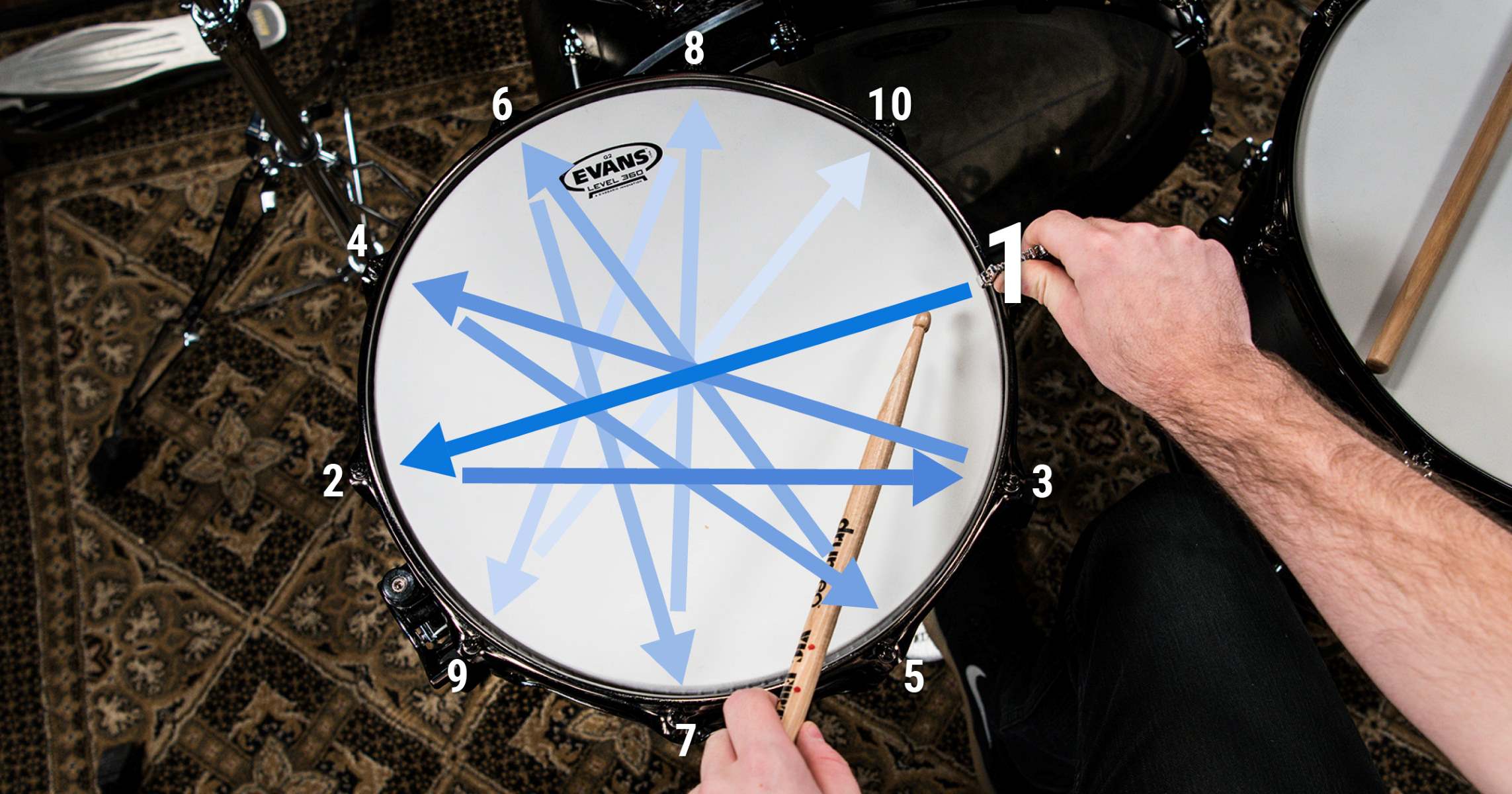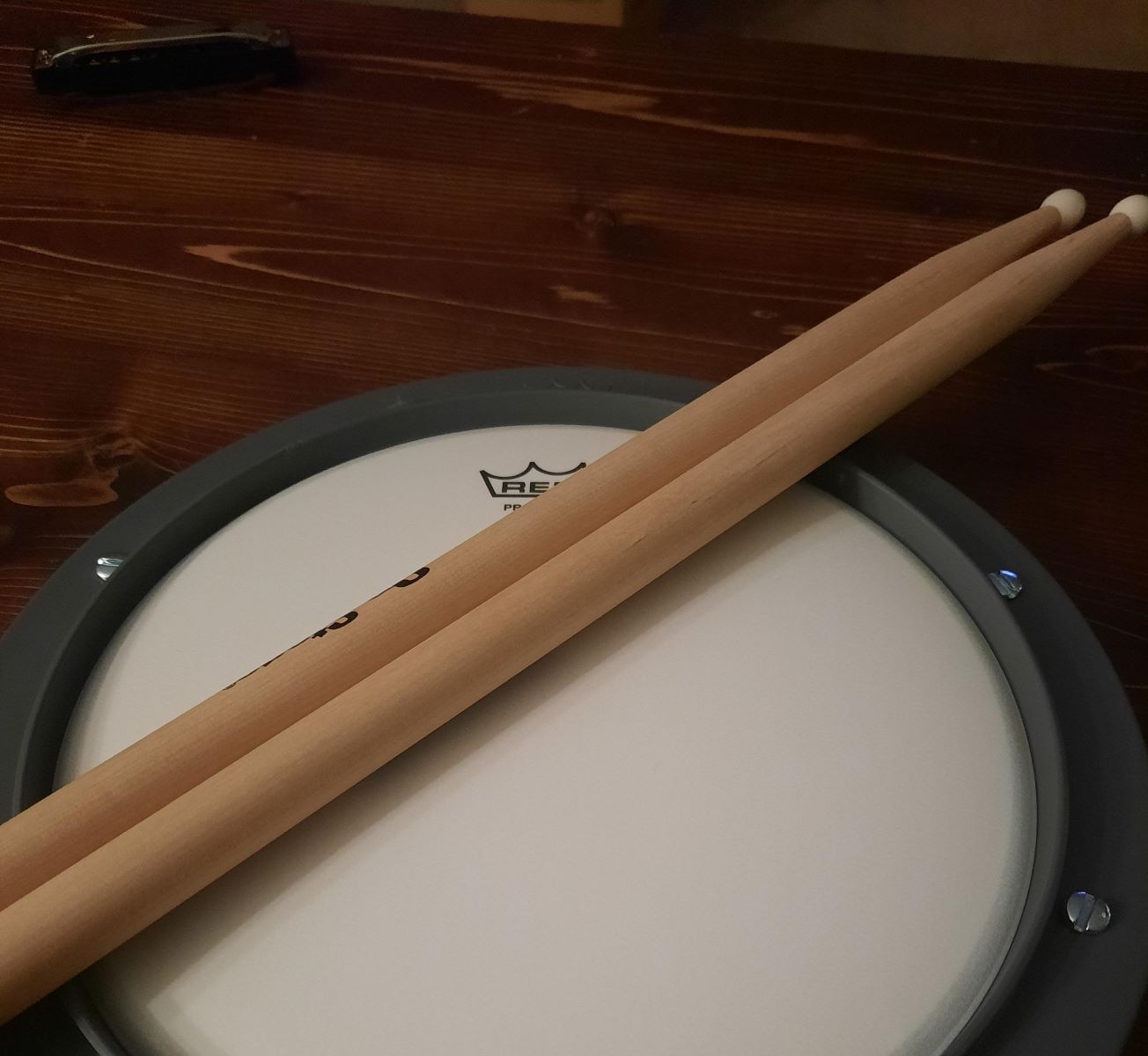Home>Instruments>Drums>How To Teach Yourself The Drums


Drums
How To Teach Yourself The Drums
Published: February 7, 2024
Learn how to teach yourself the drums with expert tips and techniques. Master the art of drumming at your own pace and skill level. Ideal for beginners and self-learners.
(Many of the links in this article redirect to a specific reviewed product. Your purchase of these products through affiliate links helps to generate commission for AudioLover.com, at no extra cost. Learn more)
Table of Contents
Introduction
So, you've decided to dive into the world of drumming! Whether you're drawn to the thunderous beats of rock, the intricate rhythms of jazz, or the pulsating energy of pop music, learning to play the drums can be an incredibly rewarding journey. Not only does it provide an outlet for creativity and self-expression, but it also offers a unique physical and mental workout.
The beauty of learning the drums is that you can do it at your own pace and on your own terms. While many aspiring drummers opt for formal lessons, there's a wealth of resources available for those who prefer a more independent approach. In this article, we'll explore the process of teaching yourself the drums, from selecting the right equipment to honing your technique and developing your own style.
Embarking on this musical adventure requires dedication, patience, and a willingness to embrace the learning process. Whether you're a complete novice or an experienced musician looking to expand your skill set, the journey to mastering the drums is filled with excitement and discovery. So, grab your drumsticks, set up your practice space, and get ready to unleash your inner rhythm!
Getting Started
Before diving headfirst into the world of drumming, it’s important to set the stage for your musical journey. Start by designating a dedicated practice area where you can hone your skills without distractions. This could be a spare room, a corner of your garage, or any space where you can set up your drum kit without limitations. Ensuring that your practice space is comfortable and conducive to focused learning will lay the foundation for productive practice sessions.
Next, familiarize yourself with the basic components of a drum kit. From the snare drum and bass drum to the hi-hat and cymbals, understanding the role of each element will provide insight into the instrument’s versatility and potential for creativity. Additionally, take the time to explore different drumming styles and genres to identify the specific sounds and techniques that resonate with you. Whether you’re drawn to the explosive energy of rock or the complex rhythms of Latin percussion, exposing yourself to diverse musical styles will enrich your drumming experience.
As you embark on this journey, it’s essential to cultivate a mindset of curiosity and openness. Embrace the learning process with a sense of wonder and a willingness to experiment. Remember, every great drummer started as a beginner, and the path to mastery is paved with exploration and persistence. By approaching your drumming journey with a spirit of adventure, you’ll lay the groundwork for a fulfilling and enriching experience.
Choosing the Right Equipment
When venturing into the realm of drumming, selecting the right equipment is a crucial step that can significantly impact your learning experience. While a complete drum kit with multiple drums and cymbals offers a comprehensive playing experience, it may not be feasible for everyone, especially beginners. In such cases, starting with a basic setup consisting of a snare drum, bass drum, hi-hat, and a single cymbal can provide a solid foundation for learning essential techniques.
It’s important to consider the quality and suitability of the equipment you choose. While entry-level drum kits are available at affordable prices, investing in durable and well-crafted instruments can enhance your playing experience and ensure longevity. Additionally, exploring electronic drum kits can offer a quieter practice alternative while providing access to a wide range of sounds and features.
Furthermore, don’t underestimate the significance of drumsticks and drumheads. Experimenting with different types of drumsticks, such as nylon-tipped or wooden sticks, can influence the tone and feel of your playing. Similarly, varying the tension and material of drumheads can produce distinct sounds, allowing you to customize your kit to suit your preferences.
As you navigate the process of acquiring drumming equipment, don’t overlook the importance of ergonomic and adjustable hardware. Properly positioning your drum throne, adjusting the height and angle of your cymbals and drums, and ensuring the stability of your hardware are essential for maintaining comfort and preventing strain during extended practice sessions.
Ultimately, the goal is to assemble a drum kit that not only meets your current needs but also accommodates your growth as a drummer. Whether you opt for an acoustic or electronic setup, prioritize selecting instruments and hardware that inspire and support your musical exploration.
Basic Techniques
Mastering fundamental drumming techniques is essential for building a strong rhythmic foundation and unlocking your potential as a drummer. One of the most fundamental techniques is the proper grip and stroke of the drumsticks. Whether you prefer the traditional grip or the matched grip, developing a comfortable and controlled hold on the sticks is paramount. Experiment with different grip styles to find the one that feels most natural to you.
Rudiments, the basic patterns and exercises used in drumming, form the building blocks of drumming technique. Practicing rudiments such as single strokes, double strokes, paradiddles, and flams not only hones your coordination and control but also lays the groundwork for more advanced patterns and fills. Devote time to mastering these rudiments, as they serve as the vocabulary of drumming, allowing you to express yourself fluently on the drum kit.
Understanding the concept of dynamics is another crucial aspect of drumming technique. Learning to control the volume and intensity of your playing adds depth and expression to your performances. Experiment with varying degrees of force and touch to explore the full spectrum of sound that the drums can produce, from delicate whispers to thunderous roars.
Additionally, developing a strong sense of timing and rhythm is fundamental to becoming a proficient drummer. Practicing with a metronome or drumming along to music can help you internalize different tempos and improve your overall rhythmic precision. Cultivating a keen awareness of timing will not only enhance your ability to play with other musicians but also elevate the impact of your drumming in any musical context.
Lastly, don’t underestimate the importance of posture and body mechanics. Maintaining proper posture while playing the drums not only prevents physical strain and injury but also facilitates fluid and efficient movement around the drum kit. Pay attention to your sitting position, posture, and the ergonomics of your drum setup to ensure a comfortable and sustainable playing experience.
By dedicating time and attention to mastering these basic techniques, you’ll establish a solid groundwork for your drumming journey and pave the way for continued growth and exploration as a musician.
Learning Drum Notation
Understanding drum notation is a valuable skill that empowers drummers to interpret and communicate musical ideas effectively. Unlike traditional sheet music, which primarily represents melody and harmony, drum notation is tailored to capture the nuances of rhythm and percussion. Learning to read drum notation opens up a world of musical possibilities and facilitates seamless collaboration with other musicians.
Drum notation employs a system of unique symbols and markings to represent different components of the drum kit. From the snare drum and bass drum to various cymbals and percussion instruments, each element is assigned a specific notation, allowing drummers to accurately transcribe and interpret rhythmic patterns and compositions.
One of the fundamental aspects of drum notation is understanding the concept of note values and rhythmic subdivisions. Whether it’s mastering the difference between whole notes, half notes, quarter notes, or delving into more intricate subdivisions such as triplets and sixteenth notes, grasping these rhythmic elements is essential for accurately interpreting and reproducing drum notation.
Furthermore, familiarizing yourself with drum notation key symbols, such as the hi-hat open and closed notations, accent markings, and ghost note indications, provides insight into the expressive and dynamic aspects of drumming. These symbols offer a means of conveying the nuances of a performance, from subtle ghost notes to emphatic accents, enriching the interpretation of rhythmic patterns.
While traditional sheet music often utilizes a staff with multiple lines and spaces to represent different pitches, drum notation typically employs a single-line staff, with each position corresponding to a specific drum or percussion instrument. Understanding the layout and organization of the drum staff is integral to accurately interpreting and transcribing rhythmic patterns and drum parts.
As you delve into the world of drum notation, consider integrating technology and software tools that offer intuitive and interactive drum notation features. Utilizing drum notation software not only enhances the learning process but also provides a platform for creating and sharing your rhythmic compositions with fellow musicians.
By immersing yourself in the realm of drum notation, you’ll expand your musical literacy, enhance your ability to communicate and collaborate with other musicians, and gain a deeper appreciation for the rhythmic intricacies that define the art of drumming.
Practicing Rhythms
Consistent and focused practice is the cornerstone of mastering rhythm and honing your drumming skills. Whether you’re working on foundational patterns, exploring complex polyrhythms, or developing your improvisational abilities, dedicating regular time to practicing rhythms is essential for growth and proficiency as a drummer.
Begin by establishing a practice routine that incorporates a diverse range of rhythmic exercises. This may include rudimental practice, where you focus on mastering fundamental sticking patterns and accentuations. Additionally, integrating exercises that emphasize coordination between the hands and feet, such as bass drum ostinatos and snare drum variations, can enhance your rhythmic dexterity and control.
When practicing rhythms, it’s beneficial to approach them in a systematic and incremental manner. Start by working at a comfortable tempo, ensuring that you can execute the rhythm accurately and consistently. Once you’ve achieved proficiency at a moderate tempo, gradually increase the speed, challenging yourself to maintain precision and clarity as the tempo rises.
Exploring diverse rhythmic styles and genres is another valuable aspect of practicing rhythms. Whether you’re delving into the syncopated grooves of funk, the driving pulse of rock, or the intricate patterns of world music, immersing yourself in various rhythmic contexts expands your musical vocabulary and fosters versatility as a drummer.
Integrating play-along resources and backing tracks into your practice routine can provide an immersive and dynamic environment for applying rhythmic concepts. Playing along with music not only enhances your sense of timing and groove but also cultivates the ability to complement and interact with other musical elements, an essential skill for any drummer.
Moreover, don’t underestimate the value of practicing rhythms away from the drum kit. Utilizing practice pads and percussion instruments allows you to focus specifically on rhythm without the distractions of the full drum set. This focused approach can refine your sense of touch, dynamics, and precision, ultimately enriching your overall rhythmic proficiency.
Lastly, maintaining a positive and patient mindset during practice is crucial. Embrace the learning process with a spirit of curiosity and persistence, recognizing that rhythmic mastery is a continuous journey marked by gradual improvement and discovery.
By incorporating diverse exercises, exploring varied rhythmic styles, and approaching practice with dedication and enthusiasm, you’ll cultivate a strong rhythmic foundation and elevate your drumming prowess.
Playing Along with Music
One of the most exhilarating and rewarding aspects of learning the drums is the opportunity to play along with music. Whether you’re jamming to your favorite songs, collaborating with fellow musicians, or exploring new genres, playing along with music offers a dynamic and immersive experience that enhances your rhythmic skills and musicality.
When selecting music to play along with, consider exploring a diverse range of genres and styles. This not only broadens your musical horizons but also exposes you to different rhythmic patterns, grooves, and techniques. Whether it’s the driving backbeat of rock, the syncopated rhythms of funk, or the intricate polyrhythms of world music, each genre presents unique challenges and opportunities for rhythmic exploration.
Playing along with music provides a real-world context for applying and refining your rhythmic skills. It allows you to internalize the feel and groove of different songs, adapt to varying tempos and dynamics, and develop the ability to complement and enhance the musical arrangement. This immersive experience fosters a deeper understanding of the drummer’s role in a band setting and cultivates the essential skill of playing in sync with other musicians.
Utilize play-along tracks and backing recordings as valuable resources for practicing and refining your rhythmic abilities. These resources often feature diverse musical styles, tempos, and time signatures, providing a rich tapestry of rhythmic challenges to explore. Additionally, play-along tracks offer the flexibility to isolate specific instruments or remove the drum track entirely, allowing you to assume the role of the drummer within the musical context.
Collaborating with other musicians, whether in a band setting or informal jam sessions, presents an invaluable opportunity to refine your rhythmic proficiency. Engaging in musical dialogue with other instrumentalists hones your ability to listen, adapt, and respond to the musical dynamics, fostering a strong sense of ensemble playing and musical cohesion.
Furthermore, playing along with music nurtures your creativity and improvisational skills. It encourages you to explore variations in your drumming patterns, experiment with fills and embellishments, and develop a keen sense of musical expression. This process of musical interaction and exploration contributes to the development of your unique drumming style and musical identity.
Ultimately, playing along with music transcends the realm of practice, offering an immersive and enjoyable avenue for honing your rhythmic abilities, fostering musical collaboration, and nurturing your artistic expression as a drummer.
Developing Your Own Style
As you progress on your drumming journey, cultivating your own unique style becomes a pivotal aspect of your musical development. Your individual style is an expression of your personality, creativity, and musical influences, and it distinguishes you as a drummer. Embracing the process of developing your own style empowers you to infuse your playing with authenticity, originality, and artistic flair.
One of the fundamental elements of developing your style is immersing yourself in a diverse array of musical genres and drumming traditions. Whether it’s delving into the classic rock beats of the 1970s, exploring the intricate polyrhythms of Afro-Cuban music, or embracing the pulsating grooves of contemporary pop, each genre offers a rich tapestry of rhythmic nuances and stylistic elements to draw inspiration from.
Emulate and study the playing of drumming icons and influential musicians who resonate with you. Analyze their techniques, approaches to rhythm, and signature stylistic elements. While drawing inspiration from these sources, strive to incorporate your unique voice and interpretation, infusing your playing with a personal touch that reflects your musical identity.
Experimentation and improvisation play a crucial role in the development of your style. Embrace the freedom to explore unconventional rhythmic patterns, experiment with different textures and dynamics, and integrate unexpected elements into your playing. This spirit of exploration and innovation fuels the evolution of your style and fosters a sense of artistic daring and individuality.
Developing your style also involves honing your musical intuition and sensitivity. Cultivate a keen awareness of musical phrasing, dynamics, and subtleties, allowing your playing to convey emotion and depth. The ability to infuse your drumming with expressive nuances and musical storytelling elevates your style and captivates listeners.
Collaboration and performance opportunities provide a platform for refining and showcasing your style. Whether playing in a band, participating in jam sessions, or performing live, engaging with other musicians allows you to integrate your unique style into a cohesive musical context. This collaborative environment fosters adaptability and versatility while amplifying the impact of your individual expression.
Embrace the journey of developing your style as an ongoing and organic process. Allow your influences, experiences, and artistic growth to shape and enrich your playing, recognizing that your style is a reflection of your musical evolution and creative exploration.
Ultimately, developing your own style as a drummer is a deeply personal and transformative endeavor that celebrates your artistic individuality and contributes to the vibrant tapestry of musical expression.
Conclusion
Congratulations on embarking on the exhilarating journey of teaching yourself the drums! Throughout this exploration, you’ve delved into the essential aspects of becoming a self-taught drummer, from setting up your practice space and selecting the right equipment to mastering basic techniques, interpreting drum notation, and developing your unique style. As you continue on this musical odyssey, remember that the path to becoming a proficient drummer is marked by dedication, curiosity, and a passion for rhythmic expression.
Teaching yourself the drums offers a canvas for boundless creativity and self-discovery. Embrace the diverse rhythmic landscapes of different genres, immerse yourself in the language of drum notation, and revel in the joy of playing along with music. Each practice session is an opportunity for growth, refinement, and the cultivation of your individual drumming style.
As you progress, remember that the journey of learning the drums is not merely about mastering technical proficiency, but also about nurturing your musical intuition, expressive depth, and collaborative spirit. Whether you find yourself jamming with fellow musicians, performing in a live setting, or simply reveling in the joy of rhythmic exploration, cherish each moment as a stepping stone in your evolution as a drummer.
Above all, maintain a sense of enthusiasm and resilience. Embrace the challenges and triumphs that accompany the pursuit of rhythmic mastery, recognizing that each obstacle surmounted and every breakthrough achieved contributes to your growth as a musician.
As you continue to hone your craft, remember that the essence of drumming lies not only in technical prowess but also in the ability to convey emotion, tell stories, and connect with others through rhythm. Your journey as a self-taught drummer is a testament to your passion, creativity, and unwavering dedication to the art of drumming.
So, pick up your drumsticks, immerse yourself in the pulsating rhythms of your favorite music, and let the beat of your heart resonate through your playing. The world of drumming eagerly awaits your unique voice, and the rhythm of your journey is a symphony in the making.











